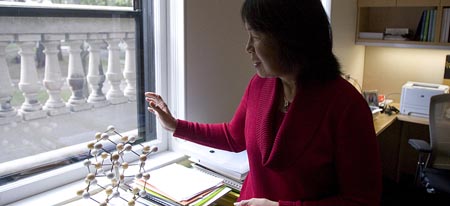Home > Press > Big-picture view of nanoscale
 |
| Kris Snibbe/Harvard Staff Photographer Evelyn Hu, Gordon McKay Professor of Applied Physics and Electrical Engineering, shows a model of gallium arsenide. Hu has joined Harvard's School of Engineering and Applied Sciences after spending 25 years at the University of California, Santa Barbara. |
Abstract:
Evelyn Hu brings her trademark creativity, versatility to SEAS
Big-picture view of nanoscale
Cambridge, MA | Posted on October 15th, 2009Great scientists tend to share a certain versatility and creative spark. Think of Galileo Galilei questioning the constant night sky. Consider how James Watson and Francis Crick helped to create biochemistry from scratch. Among other things, great scientists combine approaches. They ignore boundaries.
Creativity and versatility have come naturally to Evelyn Hu, who joined Harvard's School of Engineering and Applied Sciences this year as Gordon McKay Professor of Applied Physics and Electrical Engineering. Hu has been developing innovative nanoscale materials since taking her first faculty job at the University of California, Santa Barbara, in 1984. Her search for more versatile materials has led her to dabble repeatedly in biology over her long and successful career.
"I have always had this respect, this interest, this awe of what biology can do," Hu said. "That's been a theme that I've tried to continue throughout the years."
Where did this taste for the interdisciplinary come from? Hu pointed all the way back to high school and to summer science programs she attended.
"I wanted a more balanced liberal arts education, starting from the New York City school system and going through my undergraduate years," said Hu, who attended Hunter College High School and Barnard College rather than opting for more science-specific institutions.
While high school itself was broadly academic, summers during those formative years were spent at various programs for budding scientists. Computer science, mathematics, and chemistry would become indispensable in Hu's later work in applied physics. But there were also programs in biology. Hu remembers particularly a summer spent at Rockefeller University.
"The laboratory techniques were so current and so novel. It was so exciting. Perhaps because I was becoming a little more sentient at that point," she reflected, thinking of her 17-year-old self, "it really was a revelation about biology. In high school, the biology that was taught was taxonomy and things like that. It was very static."
Hu recognized that microbiology — gene expression and molecular processes — had more in common with nanoscale electronics than it might at first appear. Her work has consistently pushed the boundaries of electrical engineering by incorporating elements of the organic.
"It's not just semiconductors anymore," she said.
Hu also traces her scientific interests back to her family roots.
"My parents came from China in the 1940s as students," she said. "In that generation, for immigrants, science was not only a means of achieving credibility for China but was also a way to provide security for their children. Their heroes were scientists."
Among her parents' heroes was C.S. Wu, the renowned Chinese-born physicist and first female president of the American Physical Society. Wu would become Hu's doctoral adviser, a pairing that Hu described as "not accidental."
After 25 years at the University of California, Santa Barbara, what made Hu pick up and move across the country to Harvard?
"It's really unusual if you're at an advanced stage in your career for people to give you a chance to do something different," Hu said. "It's a little scary. With every change you make, you have the opportunity to fail. It takes you out of your comfort zone, out of an environment where everybody knows your name."
"Even I was a little surprised that that was something I wanted," she added with a laugh, "It's good to be flexible."
####
For more information, please click here
Copyright © Harvard University
If you have a comment, please Contact us.Issuers of news releases, not 7th Wave, Inc. or Nanotechnology Now, are solely responsible for the accuracy of the content.
| Related News Press |
News and information
![]() Researchers develop molecular qubits that communicate at telecom frequencies October 3rd, 2025
Researchers develop molecular qubits that communicate at telecom frequencies October 3rd, 2025
![]() Next-generation quantum communication October 3rd, 2025
Next-generation quantum communication October 3rd, 2025
![]() "Nanoreactor" cage uses visible light for catalytic and ultra-selective cross-cycloadditions October 3rd, 2025
"Nanoreactor" cage uses visible light for catalytic and ultra-selective cross-cycloadditions October 3rd, 2025
Profiles
![]() Russia’s Nano-enabled Products Market to Witness Massive Growth February 8th, 2011
Russia’s Nano-enabled Products Market to Witness Massive Growth February 8th, 2011
![]() Adept Technology Announces Orders for Over $600K from Chinese Partner January 18th, 2011
Adept Technology Announces Orders for Over $600K from Chinese Partner January 18th, 2011
![]() Nanostart-held ItN Nanovation Receives Major Follow-on Order in Saudi Arabia November 29th, 2010
Nanostart-held ItN Nanovation Receives Major Follow-on Order in Saudi Arabia November 29th, 2010
![]() Homegrown Companies Developing Batteries for Clean Energy Storage November 2nd, 2010
Homegrown Companies Developing Batteries for Clean Energy Storage November 2nd, 2010
Announcements
![]() Rice membrane extracts lithium from brines with greater speed, less waste October 3rd, 2025
Rice membrane extracts lithium from brines with greater speed, less waste October 3rd, 2025
![]() Researchers develop molecular qubits that communicate at telecom frequencies October 3rd, 2025
Researchers develop molecular qubits that communicate at telecom frequencies October 3rd, 2025
![]() Next-generation quantum communication October 3rd, 2025
Next-generation quantum communication October 3rd, 2025
![]() "Nanoreactor" cage uses visible light for catalytic and ultra-selective cross-cycloadditions October 3rd, 2025
"Nanoreactor" cage uses visible light for catalytic and ultra-selective cross-cycloadditions October 3rd, 2025
|
|
||
|
|
||
| The latest news from around the world, FREE | ||
|
|
||
|
|
||
| Premium Products | ||
|
|
||
|
Only the news you want to read!
Learn More |
||
|
|
||
|
Full-service, expert consulting
Learn More |
||
|
|
||








